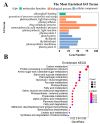Dissecting the Regulatory Network of Leaf Premature Senescence in Maize (Zea mays L.) Using Transcriptome Analysis of ZmELS5 Mutant
- PMID: 31752425
- PMCID: PMC6895817
- DOI: 10.3390/genes10110944
Dissecting the Regulatory Network of Leaf Premature Senescence in Maize (Zea mays L.) Using Transcriptome Analysis of ZmELS5 Mutant
Abstract
Leaf premature senescence largely determines maize (Zea mays L.) grain yield and quality. A natural recessive premature-senescence mutant was selected from the breeding population, and near-isogenic lines were constructed using Jing24 as the recurrent parent. In the near-isogenic lines, the dominant homozygous material was wild-type (WT), and the recessive material of early leaf senescence was the premature-senescence-type ZmELS5. To identify major genes and regulatory mechanisms involved in leaf senescence, a transcriptome analysis of the ZmELS5 and WT near-isogenic lines (NILs) was performed. A total of 8,796 differentially expressed transcripts were identified between ZmELS5 and WT, including 3,811 up-regulated and 4,985 down-regulated transcripts. By combining gene ontology, Kyoto Encyclopedia of Genes and Genomes, gene set, and transcription factor enrichment analyses, key differentially expressed genes were screened. The senescence regulatory network was predicted based on these key differentially expressed genes, which indicated that the senescence process is mainly regulated by bHLH, WRKY, and AP2/EREBP family transcription factors, leading to the accumulations of jasmonic acid and ethylene. This causes stress responses and reductions in the chlorophyll a/b-binding protein activity level. Then, decreased ATP synthase activity leads to increased photosystem II photodamage, ultimately leading to leaf senescence.
Keywords: leaf premature senescence; maize (Zea mays L.); regulatory networks; transcriptome analysis.
Conflict of interest statement
Authors declare no conflict of interest.
Figures











References
-
- Ra R. Selectable traits to increase crop photosynthesis and yield of grain crops. J. Exp. Bot. 2000;51:447–458. - PubMed
Publication types
MeSH terms
Substances
LinkOut - more resources
Full Text Sources
Research Materials

